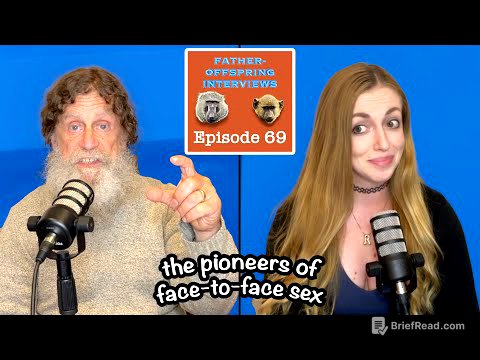TLDR;
This episode explores the myths and realities of the American West, focusing on the gunfighter era, honor culture, and the process of civilization. It examines why society romanticizes outlaws, the role of violence and impulsivity, and the historical context that shaped the West's unique character. The conversation touches on the evolution of law enforcement, the impact of the Civil War, and the enduring fascination with the Wild West in American culture.
- The romanticization of outlaws reflects a fascination with those who defy societal rules and a projection of hopes and insecurities.
- Honor culture, particularly in the South and West, served as a social ranking system where responding to insults with violence was crucial for maintaining status.
- The gunfighter era, though often mythologized, was a period of extreme violence and lawlessness, influenced by factors like alcohol, impulsivity, and the availability of guns.
Introduction [0:00]
The host introduces Brian Burrow, an author, to discuss the concept of honor culture, the process of civilization, and the struggle between law and order versus chaos in the Old West. The conversation aims to explore stoic themes and understand the various factors that contributed to the gunfights and violence of that era.
The Allure of Outlaws and Criminals [1:07]
The discussion begins with a quote from Hunter S. Thompson about myths and legends in America, which provide an illusion of infinite possibility. The conversation explores why society romanticizes murderers, terrorists, outlaws, and bank robbers, suggesting that these figures represent a form of rebellion against the constraints of civilized life. People are fascinated by those who live outside the rules, sticking it to the man, even if their actions are objectively bad. This fascination allows individuals to vicariously experience a life beyond societal norms while reaffirming their own choices to live within those norms.
Distance and Symbolism in Celebrating Outlaws [3:30]
The appeal of outlaws lies in the distance people have from their actions; they celebrate the symbolism of rebellion without experiencing the direct consequences of violence. This is particularly true during times of oppression, such as the Depression era, when figures like John Dillinger were cheered for sticking it to the man. People project their hopes and fantasies onto these figures, seeing them as a way to escape the tyranny of their own lives. This phenomenon is especially pronounced among American men, who are often raised with the idea that they can achieve anything, leading to feelings of depression if they fail to meet these expectations.
The Reality of Outlaws and Criminals [6:31]
Most criminals are not making great business decisions or opting out of successful careers; they are often losers who didn't have other viable options. The romanticized image of cultured and intelligent outlaws is a projection, a way to make them seem less like failures. The use of three names for serial killers is a journalistic convention that also makes them appear more important. Despite the different forms of outlaws throughout history, there is a common thread of breaking free from society and going on the run, which captivates the public.
Tombstone and the Ever-Present Issue of Guns [9:31]
A visit to Tombstone during the pandemic highlights the enduring debate over gun control. A sign prohibiting guns inside a saloon underscores the full circle nature of the issue, echoing editorials from the 1880s. Open carry laws were stricter in the past, though enforcement was lax unless someone was acting up. The purpose of carrying a gun has shifted from a tool for life, used for killing varmints and protecting against wildlife, to a response to a pervasive sense of risk and danger.
The Social Dynamics of the Wild West [12:51]
People who moved to the Wild West were often those having trouble functioning in society, seeking to escape rather than find opportunity. This concentration of individuals with poor socialization skills, combined with the prevalence of guns and alcohol, naturally led to conflict. Honor culture and poor socialization created a perfect storm for violence. The gunfighter era, though mythologized, occurred later than many realize, with events like the gunfight at the O.K. Corral happening after the invention of the light bulb.
The Evolution of Conflict Resolution [15:02]
Revolvers became popular in the 1840s, but widespread open carry became common after the U.S. government auctioned off surplus guns from the Civil War in the mid-1860s. This changed conflict resolution, replacing knife fights and gouging with quicker, more deadly gunfights. Conflicts in the West were often trivial, fueled by alcohol and hurt feelings, rooted in the honor culture of the antebellum South. The term "fight" implied a gunfight, reflecting the normalization of violence.
Dueling Culture vs. Gunfighter Culture [17:05]
Ulysses S. Grant questioned the delayed gratification of dueling, contrasting it with the immediacy of gunfighter culture. Dueling had a ritualistic element and served as a release valve, preventing spontaneous street fights. Gunfighter culture, however, descended into immediate gratification and recklessness. The types of people drawn to the West were impulsive, not considering the consequences of their actions, which contributed to the prevalence of conflict.
The Prevalence of Honor Culture [19:41]
Honor culture was more prevalent in the South due to less education and fewer markers of success, making social ranking difficult. Honor became the way to keep score, with insults requiring a response to maintain status. Making people afraid was a way to establish oneself, especially for those lacking other distinctions. Slavery also played a role in social marking, indicating wealth and prestige. Honor was selectively important, not necessarily reflecting virtue but rather a superficial code of conduct.
North vs. South and the Wild West [23:35]
The North replaced the worship of honor with virtue, while the South retained honor culture, which persisted on the frontier. The West was up for grabs between Northern and Southern influences, leading to conflicts between northerners and southerners in distant locations. Honor explains many Old West gunfights, but North-South antagonisms also played a significant role. Texans were particularly sensitive to perceived slights from Yankee sheriffs, as it would damage their reputation among their peers.
The Timing and Geography of the Gunfighter Era [25:38]
The gunfighter era overlapped with modern events, such as Eisenhower's childhood, highlighting how recent this history is. MacArthur grew up in Indian forts on the frontier, influencing his formative experiences. Texas had both Southern honor culture and violent frontiers, contributing to its reputation for violence. Lyndon Johnson's decisions in Vietnam were influenced by the cowboy mentality he grew up with, reflecting a fear of being seen as cowardly.
The Realities of Frontier Life [30:32]
Robert Caro noted that the Texas women were the truly tough ones, enduring the daily hardships of frontier life. The Native American frontier in Texas was not cleared until the 1870s, and violence was a constant presence. The focus on gunfighters often overshadows the ordinary people who worked to create a semblance of normalcy amidst the depravity. Academic history has shifted towards social history, recognizing the instrumental role of normal people in shaping the flow of history.
Myths and Realities of Western Figures [33:29]
The bank robber is often more fascinating than the bank president or teller, reflecting a preference for exciting stories over mundane realities. The role of Doc Holiday, as portrayed by Val Kilmer, was like putting clothes on a ghost, as there was not much substance to the real figure. Wyatt Earp is the most important gunfighter because his reputation has grown, standing for law and order and fighting for basic things that people want.
Lawlessness vs. Law and Order [38:11]
In the early years of the West, law enforcement was largely absent, leading to widespread chaos. The reintroduction of the Texas Rangers and figures like Wyatt Earp brought about a change, eliminating the worst of the anarchy. While their methods would not be tolerated today, they were fighting against organized crime and anarchy. The black and white perception of these stories only emerged afterward, as the facts were sorted out over time.
Civilization Reconstituting Itself [41:53]
Civilization was reconstituting itself in the West, with towns emerging from nothing. The scale of violence and disorder was immense, with towns experiencing murders weekly and shootings daily. Advanced data analysis has revealed the spectacularly homicidal nature of the Wild West. Society has made progress in solving downward spirals, such as the hole in the ozone layer, through hard work and innovation. The process of civilizing lawless places involved year-by-year advancements, from grass streets to established buildings.
The Arc of Lawlessness and Civilization [45:09]
The arc of lawlessness and civilization is a recurring theme in the author's books, from corporate raiding to the Wild West. Federal law enforcement was invented to respond to problems, leading to the world we live in now. The Wild West metaphor is used to describe any unregulated, chaotic situation, reflecting a personality type drawn to the wild. Wyatt Earp left Dodge City for Tombstone because Dodge was losing the snap that men of restless blood need.
The Geography and Reinvention of the West [49:57]
The geography of the West is often misunderstood, with people migrating from the East and the West. The Earp family moved to San Bernardino before returning East. The ability to reinvent oneself by moving to the next place was common, with individuals escaping their pasts. Sutter's Fort was built by Hawaiian labor, highlighting the diverse influences in the West. People forget that Europeans lived in Santa Fe, New Mexico, before the British arrived in Jamestown.
Texas and the American Dream [53:43]
Texas has a unique history and culture, with Texans never tiring of discussing it. San Antonio is a major international city, known for its basketball team. Texas punches above its weight culturally, with a strong sense of exceptionalism. The Earp family's presence in San Bernardino seems geographically incongruous. The American Dream, the idea that "it could be me," drove many to take extreme risks in pursuit of wealth and opportunity.
Risk-Taking and the Unsettled [1:00:21]
Many people put their fate in the hands of seemingly unreliable individuals, driven by the hope of hitting it rich. The lack of available information may have made it easier to take such risks. There must be a risk-taking DNA that draws people to the unsettled unknown. California and Florida continue to be risk-taking cultures, drawing the unsettled with the promise of the impossible dream.









